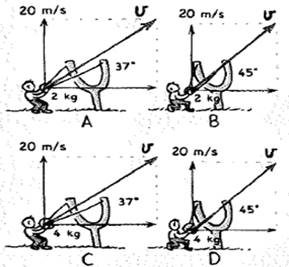
Water balloons of different masses are launched by slingshots at different launching velocities v. All have the same vertical component of launching velocities.

a. Rank by the time in the air, from longest to shortest.
b. Rank by the maximum height reached, from highest to lowest.
c. Rank by the maximum range, from greatest to least.
(a)
To rank: The balloons on the basis of time in the air, from longest to shortest.
Answer to Problem 16A
The rank of balloons is,
Explanation of Solution
Given:
Water balloons of different masses are launched by slingshots at different launching velocities as shown below.

Formula used:
Horizontal component of initial velocity of projectile is,
Vertical component of initial velocity of projectile is
Where,
u is the initial velocity.
Time of flight is the amount of time required for projectile to complete its trajectory,
Calculation:
Consider case ( A )
Vertical component of velocity is,
Time of flight is
Consider case ( B )
Vertical component of velocity is,
Time of flight is
Consider case ( C )
Vertical component of velocity is,
Time of flight is
Consider case ( D )
Vertical component of velocity is,
Time of flight is
Conclusion:
Therefore, time in the air, from longest to shortest is,
(b)
To rank: The balloons on the basis of maximum height reached, from highest to lowest.
Answer to Problem 16A
The rank of balloons is,
Explanation of Solution
Given:
Water balloons of different masses are launched by slingshots at different launching velocities as shown below.

Formula used:
Calculation:
Consider case ( A )
Maximum height is,
Consider case ( B )
Consider case ( C )
Consider case ( D )
Conclusion:
Maximum height reached, from highest to lowest is,
(c)
To rank: The balloons on the basis of maximum range, from greatest to least.
Answer to Problem 16A
Maximum range, from greatest to least is,
Explanation of Solution
Given:
Water balloons of different masses are launched by slingshots at different launching velocities as shown below.

Formula used:
Range of projectile is,
Calculation:
Consider case ( A )
Range of projectile is,
Consider case ( B )
Range of projectile is
Consider case ( C )
Range of projectile is,
Consider case ( D )
Range of projectile is,
Conclusion:
Therefore, maximum range, from greatest to least is,
Chapter 5 Solutions
Conceptual Physics: The High School Physics Program
Additional Science Textbook Solutions
Campbell Essential Biology (7th Edition)
Cosmic Perspective Fundamentals
Chemistry: An Introduction to General, Organic, and Biological Chemistry (13th Edition)
Organic Chemistry (8th Edition)
Campbell Biology (11th Edition)
Chemistry: A Molecular Approach (4th Edition)
- please answer this asap!!!!arrow_forwardRT = 4.7E-30 18V IT = 2.3E-3A+ 12 38Ω ли 56Ω ли r5 27Ω ли r3 28Ω r4 > 75Ω r6 600 0.343V 75.8A Now figure out how much current in going through the r4 resistor. |4 = unit And then use that current to find the voltage drop across the r resistor. V4 = unitarrow_forward7 Find the volume inside the cone z² = x²+y², above the (x, y) plane, and between the spheres x²+y²+z² = 1 and x² + y²+z² = 4. Hint: use spherical polar coordinates.arrow_forward
 College PhysicsPhysicsISBN:9781305952300Author:Raymond A. Serway, Chris VuillePublisher:Cengage Learning
College PhysicsPhysicsISBN:9781305952300Author:Raymond A. Serway, Chris VuillePublisher:Cengage Learning University Physics (14th Edition)PhysicsISBN:9780133969290Author:Hugh D. Young, Roger A. FreedmanPublisher:PEARSON
University Physics (14th Edition)PhysicsISBN:9780133969290Author:Hugh D. Young, Roger A. FreedmanPublisher:PEARSON Introduction To Quantum MechanicsPhysicsISBN:9781107189638Author:Griffiths, David J., Schroeter, Darrell F.Publisher:Cambridge University Press
Introduction To Quantum MechanicsPhysicsISBN:9781107189638Author:Griffiths, David J., Schroeter, Darrell F.Publisher:Cambridge University Press Physics for Scientists and EngineersPhysicsISBN:9781337553278Author:Raymond A. Serway, John W. JewettPublisher:Cengage Learning
Physics for Scientists and EngineersPhysicsISBN:9781337553278Author:Raymond A. Serway, John W. JewettPublisher:Cengage Learning Lecture- Tutorials for Introductory AstronomyPhysicsISBN:9780321820464Author:Edward E. Prather, Tim P. Slater, Jeff P. Adams, Gina BrissendenPublisher:Addison-Wesley
Lecture- Tutorials for Introductory AstronomyPhysicsISBN:9780321820464Author:Edward E. Prather, Tim P. Slater, Jeff P. Adams, Gina BrissendenPublisher:Addison-Wesley College Physics: A Strategic Approach (4th Editio...PhysicsISBN:9780134609034Author:Randall D. Knight (Professor Emeritus), Brian Jones, Stuart FieldPublisher:PEARSON
College Physics: A Strategic Approach (4th Editio...PhysicsISBN:9780134609034Author:Randall D. Knight (Professor Emeritus), Brian Jones, Stuart FieldPublisher:PEARSON





